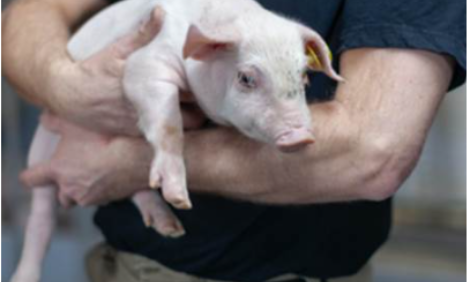



PK/PD Relationships of Denagard in Drinking Water for the Treatment of Ileitis
Pharmacokinetic/pharmacodynamic (PK/PD) relationships of DenagardTM (tiamulin) in drinking water for the treatment of ileitis by David Burch (Octagon Services Ltd, UK) and Ulrich Klein (Novartis Animal Health Inc.) and presented as a poster at the ESPHM conference in Bruges, Belgium in April 2012.Objectives
The objective of the work was to compare the pharmacokinetics (PK) of the estimated tiamulin ileum contents concentration (ICC) and compare this with the intracellular minimum inhibitory concentrations (iMICs) against Lawsonia intracellularis, the cause of Porcine Proliferative Enteropathy (PPE) ‘ileitis’ (see Photo 1 and 2), derived from laboratory studies (pharmacodynamics – PD) and evaluate the clinical efficacy of the drug when administered in the drinking water in an artificial infection study.
Materials and Methods
The tiamulin ICC was estimated using a PK model
(Burch, 2005) based on the tiamulin colonic contents
concentration (CCC) recorded by Anderson et al. (1994)
following the administration of tiamulin (Denagard®; Novartis Animal Health Inc.) via the drinking water at
60ppm for five days and compared with the iMICs derived
from Wattanaphansak et al (2009) against 10 EU and US
isolates of L. intracellularis. The test was repeated twice.
An artificial infection study was reported by Walter et al.
(2001) where pigs were infected with a pure culture of
L. intracellularis. When one or more pigs in more than 60 per cent of the
pens were showing clinical signs of ileitis, the pigs were
medicated with tiamulin at 60ppm via the drinking water
for five days. There was a 10–day observation period after
which the pigs were necropsied.
Results
The CCC was recorded at 2.16µg/g and the estimated ICC was calculated at 29 per cent of the CCC = 0.63µg/g. The MIC 90 of tiamulin against L. intracellularis was 0.12&mug/ml. The AUC/MIC was 126 and the time > MIC 90 was 100 per cent (see Figure 1).

(Wattanaphansak et al., 2009)
In the artificial infection study, the clinical signs almost disappeared by day 3 in the treated pigs (see Figure 2) and at necropsy, the gross lesions in the ileum were significantly reduced from 50 per cent in the untreated controls to eight per cent in the treated pigs and the microscopic lesions from 82 per cent to seven per cent, respectively (see Figure 3).

(Walter et al., 2001) – (MIC of the organism 0.25µg/ml)

(Walter et al., 2001)
Conclusions
Using the ICC and the intracellular MIC of tiamulin appears to give a good correlation for the prediction of efficacy for the treatment of ileitis, when administered in the drinking water at 60ppm. This anticipated efficacy was confirmed in an artificial challenge study.
Further Reading
|
| - | Find out more information on ileitis by clicking here. |
May 2012








